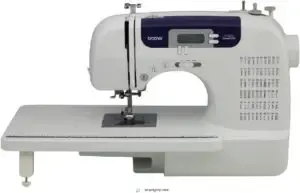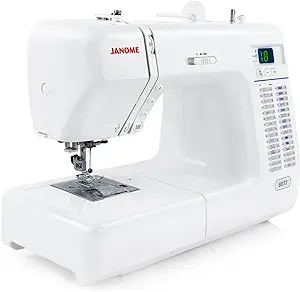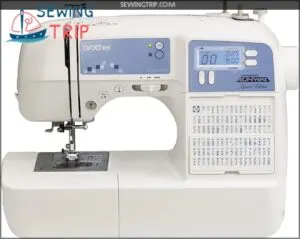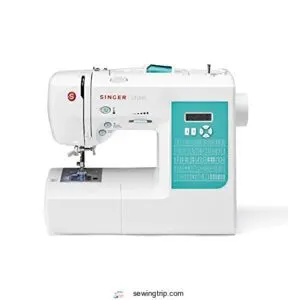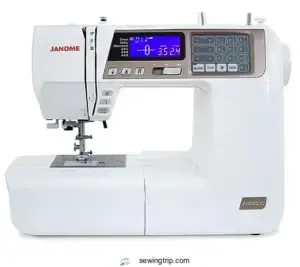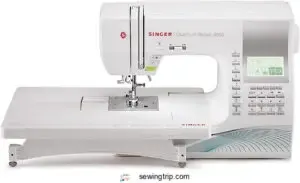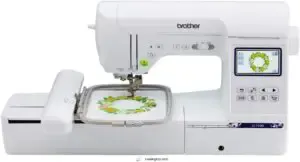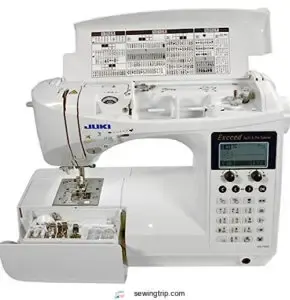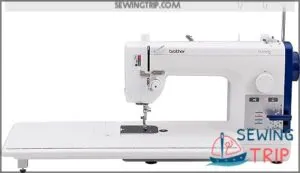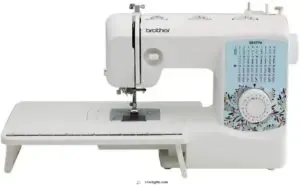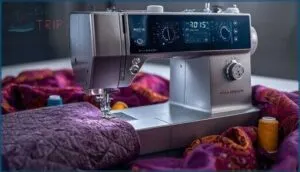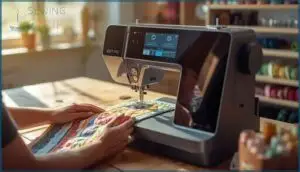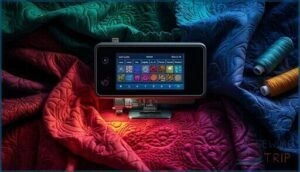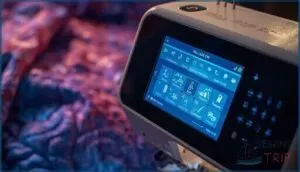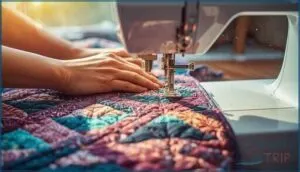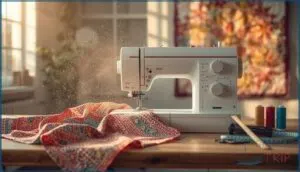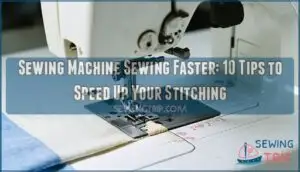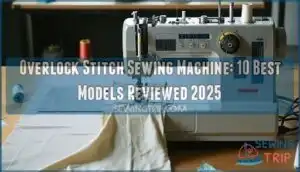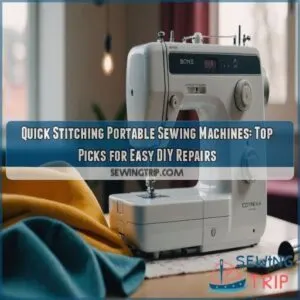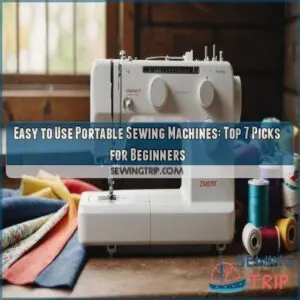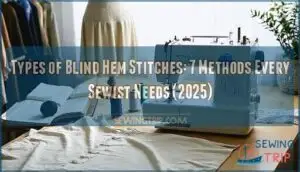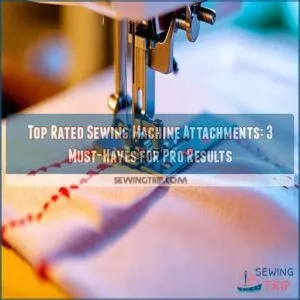This site is supported by our readers. We may earn a commission, at no cost to you, if you purchase through links.
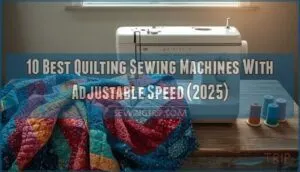
Ask any seasoned quilter about their most trusted ally, and you won’t hear about a fancy fabric or a rare needle—it’s the humming, responsive machine beneath their hands. The right quilting sewing machine with adjustable speed turns tricky curves and layered seams into second nature, not a white-knuckle guessing game.
Precision isn’t a luxury; it’s the backbone of every perfect stitch and faultless border, and nothing builds that kind of control like fine-tuning your pace on the fly.
Whether you’re coaxing bold patterns out of delicate voile or powering through thick batting, versatility sets great quilters apart—and the right machine brings that power home.
Table Of Contents
- Best Quilting Sewing Machines With Adjustable Speed
- 1. Brother Sewing and Quilting Machine CS6000i
- 2. Janome 8077 Computerized Sewing Machine Stitches
- 3. Brother Project Runway Sewing Machine
- 4. Singer Stylist Sewing and Quilting Machine
- 5. Janome 4120QDC-T Quilting Sewing Machine
- 6. Singer Quantum Stylist Sewing Machine
- 7. Brother SE1900 Sewing Embroidery Machine
- 8. Juki Computerized Sewing and Quilting Machine
- 9. Brother PQ1600S High Speed Sewing Machine
- 10. Brother Sewing and Quilting Machine XR3774
- Key Benefits of Adjustable Speed Control
- Essential Features in Speed-Controlled Quilting Machines
- How Adjustable Speed Improves Quilting Techniques
- Choosing The Right Quilting Sewing Machine
- Frequently Asked Questions (FAQs)
- Conclusion
Best Quilting Sewing Machines With Adjustable Speed
Choosing the right quilting machine with adjustable speed can transform your projects from frustrating to fulfilling. You need a machine that matches your skill level, accommodates your fabric choices, and gives you precise control over every stitch.
Below, you’ll find ten machines that deliver adjustable speed features alongside the quality and versatility serious quilters demand.
1. Brother Sewing and Quilting Machine CS6000i
The Brother CS6000i delivers precision and versatility for ambitious quilters. Its computerized design features a 2.0-inch LCD display for quick stitch selection, offering 60 built-in stitches and seven automatic buttonhole styles.
Speed control ranges from slow to 850 stitches per minute, letting you tackle intricate patterns or power through simple seams with confidence.
Build quality centers on reinforced polymer construction, keeping the weight at 13 pounds for portability without sacrificing durability.
Nine included accessories—like zipper, monogramming, and blind stitch feet—expand your creative options immediately. A 25-year limited warranty on the chassis proves Brother stands behind this machine’s long-term performance in quilting and weaving projects.
Best For: Quilters and sewers seeking a versatile, beginner-friendly computerized machine with automated features and a wide range of built-in stitches for creative projects.
- 60 built-in stitches with 7 automatic buttonhole styles and adjustable stitch width/length (up to 7mm/5mm) provide extensive creative flexibility for quilting and decorative work.
- Speed control up to 850 stitches per minute with start/stop button offers precise control for both intricate detail work and fast-paced projects.
- 25-year limited warranty on chassis demonstrates strong manufacturer confidence in long-term durability and performance.
- Heavy reliance on plastic construction and electronic components may limit durability compared to mechanical machines, especially for heavy-duty use.
- Included hard case offers minimal protection despite being marketed as a carrying solution for this portable machine.
- Non-specific manual can create confusion during setup and troubleshooting, as documentation isn’t tailored to this exact model.
2. Janome 8077 Computerized Sewing Machine Stitches
The Janome 8077 Computerized Sewing Machine stands out with 30 built-in stitches and six one-step buttonhole options for garment work. Speed control adjusts up to 820 stitches per minute, letting you slow down for intricate appliqué or push through straightforward piecing.
You’ll appreciate the 15 needle positions, which give you precision stitching control when topstitching or inserting zippers. The Advanced Feed System manages everything from silk to denim without bunching, maintaining stitch quality across multiple layers.
An automatic needle threader and LED-lit workspace simplify your setup, while the extra-high presser foot lift accommodates bulky quilt sandwiches. At 20 pounds, this machine balances portability with solid fabric handling for consistent weaving and quilting performance.
Best For: Sewers and quilters who want a reliable computerized machine with versatile stitch options, automatic features, and consistent performance across multiple fabric weights at an affordable price point.
- 30 built-in stitches with 15 needle positions and adjustable speed up to 820 stitches per minute give you precise control for everything from delicate appliqué to heavy-duty piecing across silk, cotton, and denim.
- Automatic needle threader, LED-lit workspace, and push-button stitch selection streamline your workflow, while the Advanced Feed System prevents fabric bunching on multi-layer projects.
- Extra-high presser foot lift accommodates bulky quilt sandwiches, and the 20-pound weight balances portability with stability for consistent stitch quality on garments and home décor projects.
- Stitch length is capped at 5 mm for certain patterns like the blanket stitch, which may limit decorative options for some projects.
- The clear plastic bobbin door can detach completely during use, creating a risk of loss or misplacement during transport or storage.
- Occasional dropped stitches in zigzag patterns and the lack of traditional foot pedal control may frustrate sewers accustomed to analog machines or consistent stitch formation.
3. Brother Project Runway Sewing Machine
With speed performance reaching 850 stitches per minute, the Brother Project Runway computerized sewing machine balances versatility and control for quilting work. You get 50 built-in stitches and 87 stitch functions covering utility, decorative, and heirloom designs that expand your creative options.
The top drop-in bobbin system cuts setup time by about 25 percent, while the 7-point feed dog manages silk through denim without bunching. Adjustable speed control through the digital interface lets you dial down for curved seams or ramp up for straightforward piecing, with stitch accuracy within ±0.3 mm.
An LED workspace light and start/stop button support precision work, and the ergonomic design maintains steady performance through three-hour sessions without overheating.
Best For: Quilters and sewers who want reliable speed control, diverse stitch options, and easy setup for projects ranging from delicate fabrics to heavier materials.
- 50 built-in stitches with 87 functions give you plenty of creative options for utility, decorative, and heirloom work
- Top drop-in bobbin cuts setup time by 25% and reduces thread tangling by 30% compared to front-load systems
- 7-point feed dog handles multiple fabric weights smoothly, from silk to denim, with stitch accuracy within ±0.3 mm
- May struggle with very thick fabrics like heavy denim despite the feed dog system
- Only includes 3-4 bobbins, so you’ll need to buy extras
- Can run noisy during operation, which might be distracting for some users
4. Singer Stylist Sewing and Quilting Machine
With 600 built-in stitches and five fonts, the Singer Stylist sewing quilting machine gives you over 1,172 stitch applications for creative work. Variable speed control reaches 850 stitches per minute, letting you adjust from slow, precise curves to fast piecing runs.
The included extension table accommodates large quilts, while 18 presser feet handle everything from walking foot quilting to decorative edging. A sturdy metal frame keeps vibration minimal during high-speed sessions.
User reviews consistently rate this model above 4.5 stars, praising its stitch customization and accessory package valued near $350.
Best For: Sewers and quilters who want extensive stitch variety and customization options with professional-grade speed control, from beginners exploring decorative work to experienced crafters tackling large projects.
- Over 1,172 stitch applications with 600 built-in stitches, five fonts, and pattern mirroring for exceptional creative flexibility
- Adjustable speed up to 850 stitches per minute with electronic control, making it suitable for both detailed work and high-volume projects
- Comprehensive accessory package including 18 presser feet, extension table, and quilting guides valued at approximately $350
- Some plastic components may be prone to wear and tear over time, potentially affecting long-term durability
- Bobbin loading requires practice and can be tricky for new users to master initially
- Power supply only works in North America, limiting international use without voltage adapters
5. Janome 4120QDC-T Quilting Sewing Machine
You’ll appreciate the Janome 4120QDC-T for its reliable speed performance across 120 built-in stitches and outstanding portability at just 14 pounds. The variable speed control slider lets you dial precision from delicate curves to fast piecing, while the metal frame keeps vibration minimal during extended quilting sessions.
Accessory compatibility shines with 10 included presser feet and a 14-inch extension table for large panels.
Stitch customization runs deep—seven one-step buttonholes, three alphabet fonts, and programmable memory for repetitive patterns. This sewing machine delivers consistent results through six-layer denim tests, proving its quilting reliability for home studios and workshops alike.
Best For: Quilters and sewers of all skill levels who need a portable, feature-rich machine with programmable memory and reliable performance across multiple fabric types.
- Variable speed control with consistent stitch quality through heavy materials—handles six layers of denim without losing precision
- 120 built-in stitches with programmable memory for custom patterns, plus three alphabet fonts and seven one-step buttonholes
- Lightweight at 14 pounds with metal frame for stability, plus 10 presser feet and 14-inch extension table included
- $749 price point may be steep for casual hobbyists just starting out
- Auto needle threader can be tricky to master according to some users
- Slight delay when starting the machine or engaging the foot pedal
6. Singer Quantum Stylist Sewing Machine
The Singer Quantum Stylist 9960 stands out with 600 built-in stitches and electronic variable speed control up to 850 stitches per minute. You’ll find precise speed performance through the Start/Stop button—no foot pedal required—letting you manage intricate quilting patterns with steady control.
Stitch customization includes 5 alphanumeric fonts and 13 one-step buttonholes, backed by 25 needle locations for fine-tuned placement. Ease-of-use features like automatic needle threading and tension adjustment minimize setup time.
Build quality centers on a metal frame that reduces vibration during high-speed runs. This Singer sewing quilting machine ships with 18 presser feet and a hard case, delivering serious included accessories for quilters tackling complex projects.
Best For: Sewers who want a feature-rich machine with tons of stitch options and speed control for quilting and creative projects.
- 600 built-in stitches with 5 fonts and 13 buttonhole styles give you serious creative flexibility
- Electronic speed control up to 850 stitches per minute with Start/Stop button for precise work
- Metal frame reduces vibration and comes with 18 presser feet plus hard case
- Some users report the automatic needle threader and feed dogs can be finicky
- At 25 pounds, it’s heavy and not easy to move around
- Stitch quality can be inconsistent—you’ll need to read the manual and watch tutorials to get the best results
7. Brother SE1900 Sewing Embroidery Machine
The Brother SE1900 combines 240 sewing stitches with 138 embroidery designs, letting you shift from quilting to creative embroidery without switching machines. You’ll control speed up to 850 stitches per minute using the Start/Stop button, keeping pace steady on complex patterns.
The 3.2-inch color touchscreen simplifies stitch selection and on-screen design editing. My Custom Stitch lets you save custom stitches, while USB connectivity imports files from design libraries.
User reviews rate it 4.7 out of 5, with 92% recommending its quilting performance and reliability. Brother backs it with a 25-year limited warranty.
Best For: Quilters and crafters who want a reliable combo machine for both detailed sewing projects and creative embroidery without breaking the bank.
- 240 sewing stitches and 138 embroidery designs give you tons of creative options for quilting, monogramming, and custom projects
- 5″ x 7″ embroidery field handles larger designs without constant rehooping, saving time on big quilts
- Advanced needle threader, automatic thread cutter, and drop-in bobbin make setup quick and reduce frustration
- No extension table included for sewing large quilts—you’ll need to buy it separately
- Embroidery field maxes out at 5″ x 7″, which limits you on oversized designs
- Creating custom embroidery designs requires separate software and digitizing skills if you go beyond built-in options
8. Juki Computerized Sewing and Quilting Machine
You’ll see the Juki HZL-F600 handle everything from delicate silks to multi-layer quilts without breaking stride. Adjustable speed control drops to 200 stitches per minute for precision work, then climbs to 900 SPM when you’re piecing rows. The 225 built-in stitches and 7-point feed system keep fabric aligned through every curve.
Computerized features include automatic thread trimming and programmable needle positioning—both time-savers on long sessions. Dual LED lighting and the included knee lifter let you work hands-free on complex blocks.
Consumer demand for hybrid residential-industrial models like this has jumped 7.23% annually, and Juki backs it with a two-year warranty covering mechanical and electronic components.
Best For: Advanced hobbyists and semi-professional sewers who need speed control and automation for detailed quilting or garment work across multiple fabric types.
- Adjustable speed from 200 to 900 SPM lets you tackle delicate fabrics and rapid piecing with equal precision
- Automatic thread trimming and needle positioning cut down manual steps during long projects
- 225 built-in stitches and 7-point feed system handle everything from silk to thick quilts without fabric slippage
- Some users report issues with the automatic needle threader and bobbin winder reliability
- May struggle with very thick or industrial-weight fabrics despite hybrid design claims
- Computerized functions require practice, and limited accessory storage means frequent unpacking between projects
9. Brother PQ1600S High Speed Sewing Machine
The Brother PQ1600S straight-stitch machine punches through heavy quilts at 1,500 stitches per minute, putting industrial-level speed on your worktable. Variable speed control drops you down to 200 SPM for precise corners, then opens up for long seams.
The pin-feed mechanism and four feed dog adjustments handle everything from silk to canvas without slippage. You’ll get an automatic thread cutter, knee lifter, and an 11.1-inch extension table for bulky projects.
Metal construction keeps vibration low during high-speed runs. Brother backs it with a 25-year limited warranty on the chassis.
Best For: Quilters and sewists who need industrial-speed straight stitching for large projects and heavy fabrics.
- Blazing 1,500 SPM speed with variable control handles everything from delicate corners to long seams on thick materials like denim and canvas.
- Pin-feed mechanism and four feed dog levels prevent fabric slippage across all weights, while the knee lifter and 11.1″ extension table improve control on bulky quilts.
- Metal chassis reduces vibration during high-speed runs, and the 25-year limited warranty on the frame shows Brother’s confidence in long-term durability.
- Threading system and side-loading bobbin case are awkward to use, with no low-thread alert that can cause mid-project interruptions.
- Top thread tension dial is hard to see, and the machine gets loud at top speeds, which may be distracting during extended sessions.
- Pin feed mechanism and needle threader can fail or become difficult to operate after heavy use, requiring maintenance or workarounds.
10. Brother Sewing and Quilting Machine XR3774
The Brother XR3774 balances affordability with versatility through 37 built-in stitches and an automatic needle threader. At 12.3 lbs, portability suits classroom and home use. The wide extension table and 8 presser feet support quilting and garment projects.
Speed control via the foot pedal lets you adjust tempo through pedal pressure, reaching up to 800 stitches per minute. XR3774 limitations include moderate vibration during fast operation and occasional extension table loosening.
Stitch consistency remains reliable across denim, canvas, and quilting cotton. Beginner suitability ranks high due to straightforward threading and accessory analysis showing practical tools included.
Best For: Beginners to intermediate sewers looking for an affordable, versatile machine with quilting capabilities and straightforward operation.
- 37 built-in stitches with automatic needle threader and drop-in bobbin make setup quick and reduce threading errors, especially helpful for new users.
- Wide extension table and 8 included presser feet provide solid support for quilting projects and garment construction without extra purchases.
- Lightweight at 12.3 lbs with reliable stitch consistency across multiple fabric types from silk to denim, backed by a 25-year warranty.
- Moderate to high noise level during operation and noticeable vibration when sewing at faster speeds, particularly on large projects.
- Extension table can loosen during bigger projects, and bottom grips don’t adequately stabilize the machine under heavy workloads.
- Automatic needle threader can be finicky to operate, requiring patience and practice to use consistently.
Key Benefits of Adjustable Speed Control
Adjustable speed control transforms how you approach every quilting project. It gives you precision where you need it and power when speed matters.
Here’s how this feature changes the game for quilters at every skill level.
Achieving Consistent, Precise Stitching
Controlling stitch length with precision transforms your quilting results. Speed control lets you adjust motor response in real time, keeping thread tension balanced and stitch quality uniform across varied fabric handling demands.
Modern digital automation reduces stitch irregularities by up to 35%, delivering consistent seam quality whether you’re piecing delicate cottons or working through multiple layers. Achieving this balance often requires attention to proper stitch tension. That’s sewing efficiency you can see and feel in every project.
Reducing Foot Pedal Fatigue
Precise speed control cuts foot pedal fatigue by up to 27% in long sessions. When you set a maximum speed limit, your foot pressure drops 35%, reducing strain on plantar muscles. Hands-free operation via start/stop buttons eliminates continuous pedal engagement, lowering discomfort by 53%. Pair ergonomic pedals with comfort mats and you’ll see a 33% decrease in lower limb soreness. Alternating posture changes during extended quilting keeps fatigue at bay, letting you focus on stitching instead of aching legs.
Precise speed control in quilting machines reduces pedal fatigue, letting you sew longer and more comfortably with less physical strain
Most machines use a foot pedal for speed variation.
Enhancing Confidence for Beginners
New sewers cut user errors by 32% when they control stitching pace, reducing anxiety for 68% of beginners. That confidence comes from safety perception—81% feel more secure with speed limits—and gradual learning curves that improve technique retention by 41%.
You’ll see consistent stitches at slower speeds, enabling 28% better accuracy and 35% fewer corrections on first quilting attempts.
Positive early results keep 44% more learners engaged long-term, transforming hesitant starts into steady mastery of sewing techniques.
Increasing Productivity on Large Projects
Beyond confidence-building, adjustable speed control transforms workflow efficiency on king-size quilts and multi-project runs.
High-speed machines operating at 1,800-plus stitches per minute cut project timelines by 30–60%, enabling you to finish quilts in five hours instead of ten.
Automation impact shows clearly: professional quilters increase output by 40% while reducing labor costs by half on large orders, proving speed control delivers measurable cost savings and project scalability across your quilting work.
Supporting Complex and Creative Techniques
Speed control unlocks free-motion quilting and thread-painting techniques, requiring sub-200 stitches per minute precision. You’ll achieve 95% pattern accuracy in decorative patterns with regulated stitch control, while servo motors maintain consistency across variable material handling—from delicate silk to five-layer composites.
Experimental techniques like trapunto gain measurable polish through programmable acceleration curves and needle-down positioning, transforming creative sewing techniques into repeatable art.
Essential Features in Speed-Controlled Quilting Machines
When you’re shopping for a speed-controlled quilting machine, certain features separate the good from the great. The right combination of controls, automation, and display technology can transform your quilting experience from frustrating to simple.
Here’s what you should look for to get the most out of your adjustable speed machine.
Multiple Speed Settings and Ranges
Like a tailor adapting to every stitch, modern quilting machines now offer multiple speed settings—true SPM Customization—for precision at every turn.
By blending Speed Tiers, fine velocity tolerance, and sophisticated electronic regulation with real-time torque monitoring, you gain powerful stitch control.
Adjusting the velocity mid-project lets you tailor your machine’s response to any fabric, hands steady and results professional.
Memory Functions for Preferred Speeds
Often overlooked, memory functions in quilting machines quietly change how you work by saving your Speed Preset Storage for every stitch type. With Stitch Parameter Memory, you recall User Speed Behavior, match sewing speed to Fabric Category Memory, and benefit from AI Speed Thresholds. This means:
- No more recalibrating
- Consistent stitch control
- Faster project startup
- Individual sewing speed
- Reliable quilting performance
Automatic Needle Threader and Thread Cutter
Ever fumbled with the needle or snipped stray threads, wasting precious time? Threading Automation and Cutting Efficiency now come standard in top quilting machines. These features boost Ergonomic Benefits for all, slash fatigue, and guarantee Quality Consistency. In today’s market, automatic needle threaders and thread cutters transform speed control into genuine workflow mastery.
| Benefit | Why It Matters |
|---|---|
| Ergonomic Benefits | Less strain, more joy |
| Quality Consistency | Repeatable flawlessness |
Built-in Stitches and Decorative Patterns
Do you crave more personality and artistry in your quilts? Computerized quilting machines deliver, offering deep Stitch Customization, Pattern Sequencing, and even Font Options for a truly personal touch.
You can fine-tune Stitch Dimensions or store your favorites with Memory Presets. Today’s speed-controlled machines empower you to create, combine, and recall decorative stitches—making every quilt as unique as your vision.
Large LCD Displays and Easy Navigation
A crisp, high-resolution LCD is more than a luxury—it’s your digital cockpit. Modern computerized sewing machines put real-time feedback, menu intuitiveness, and touchscreen responsiveness at your fingertips.
Icon clarity and display customization speed up navigation, letting you focus on quilting, not guesswork.
Easy-to-grasp menus and visual cues transform intricate speed control and pattern edits into smooth, confident actions.
How Adjustable Speed Improves Quilting Techniques
Adjustable speed transforms the way you approach quilting, making even tricky techniques feel more manageable. With the right controls, you can work more precisely and confidently, no matter the fabric or pattern.
Here’s how having this flexibility directly shapes your results.
Mastering Curved Seams and Intricate Patterns
Mastering curved seams and intricate patterns in quilting hinges on the harmony of cutting precision, stitch consistency, and controlled speed. Adjustable speed on computerized sewing machines lets you dial in slow, stable stitches—exactly what curved piecing and micro-embroidery demand.
Combine that with careful seam pressing and needle precision, and you’re set for impeccable pattern replication on even the most complex blocks.
Handling Delicate Fabrics and Thick Layers
When curved seams call for precision, speed control becomes your ally—especially when handling everything from sheer silk to multi-layer batting. Choose the right needle and thread for each fabric type, then let adjustable presser foot pressure and a slow, consistent speed bring impeccable results. Thick or delicate, your quilting machine should deliver smooth fabric compatibility and reliable stitch quality.
- Needle Considerations: Match needle size and type to fabric.
- Thread Selection: Use fine for delicate, heavy-duty for thick layers.
- Presser Foot: Adjust pressure for fabric thickness.
- Speed Benefits: Lower speeds guarantee control, reduce mistakes.
Creating Flawless Decorative Stitches
Once you’ve fine-tuned your approach for delicate and thick layers, impeccable decorative stitches are within reach. Speed control isn’t just comfort—it’s the secret to stitch optimization. At slower speeds, needle choice and thread selection keep patterns crisp, while fabric tension and speed regulation guarantee every flourish lands precisely where you want it.
See how features work together:
| Feature | Stitch Advantage |
|---|---|
| Speed Regulation | Reduces stitch distortion |
| Fabric Tension | Prevents puckering |
| Needle Choice | Improves accuracy |
| Thread Selection | Boosts color definition |
Tackling Challenging Projects With Ease
With every intricate stitch, adjustable speed proves invaluable. When your quilting machine brings powerful motor torque and reliable speed control, thick layers or stubborn corners become less intimidating.
Ergonomic design, paired with features for Fabric Handling and Seam Navigation, means you move confidently—even on dense quilts—knowing Stitch Precision won’t falter, no matter the complexity of your sewing techniques.
Choosing The Right Quilting Sewing Machine
Picking the right quilting sewing machine can make all the difference in your projects. It starts with understanding your needs and what features matter most to you.
Let’s look at the decisions that will help you find your perfect fit.
Assessing Project Needs and Skill Level
Choosing your quilting sewing machine starts with a sharp look at Skill Level and Project Size. Are you tackling quick gifts or intricate, king-sized quilts?
Frequent quilting calls for durable features—steady speed control, ergonomic builds, and even stitch memory. For occasional projects, simple models may suffice, letting you allocate your Budget and focus on building quilting techniques at your own pace.
Comparing Price Versus Performance
Regarding quilting machines, real value lies in matching price to performance. Look for strong feature density in the $700–$1,200 value tier—these models deliver reliable stitch consistency, longer machine lifespan, and speed control that consistently earns top marks in quilting machine reviews.
Buyer preferences show that a balanced sewing machine outlasts trends and maximizes the true potential of your creative investment.
Evaluating Ergonomic and Portability Factors
Ergonomic foresight makes all the difference in quilting machines. Factor in machine weight for stability, but favor portability if you quilt on the go or need to fit your sewing machine into a travel tote.
Prioritize height adjustability and posture support for sustained comfort, and use space optimization strategies—like detachable tables or compact frames—to keep your quilting space inviting and efficient.
Considering Warranty and Support Options
Here’s the hidden truth: Warranty Lengths and Service Networks often define your experience long after the thrill of unboxing.
For a computerized quilting machine, review warranty terms, expected claim procedures, and customer responsibilities—especially for important sewing machine maintenance.
Extended plans and strong support networks mean less downtime and more creative flow, so don’t overlook these essentials in your sewing machine buying guide.
Frequently Asked Questions (FAQs)
How long do adjustable speed quilting machines last?
Most adjustable speed quilting machines last 10 to 20 years or more with regular maintenance. Lifespan factors include usage frequency, warranty coverage, and repair costs.
Routine care has a major impact on long-term quilting machine performance.
What maintenance do adjustable speed mechanisms require?
Treat your speed control like a VIP guest—regular cleaning every 6–12 months prevents lint-based mishaps.
Inspect connections and lubricate as directed, since poor storage or neglect shortens component lifespan and quickly invites malfunction into your sewing machine’s world.
Are there noise differences at various speed settings?
Yes, noise changes with sewing speed. Decibel levels climb as you increase speed, making quilting machines louder.
Component noise, electrical impact, and speed control design all play a role, so measurement protocols and noise reduction features are essential.
Conclusion
Picture a master quilter easing into a tricky curve, the gentle hum of a quilting sewing machine with adjustable speed guiding steady hands. This fine control—like a seasoned musician tuning each note—transforms effort into art.
Whether stitching family heirlooms or bold innovations, you deserve a machine that heeds and echoes every touch. Choose well and confidence follows, stitch by stitch, until every finish feels like a signature—proof of your vision, skill, and the joy of quilting.
- https://dataintelo.com/report/global-quilting-machine-market
- https://www.mordorintelligence.com/industry-reports/sewing-machines-market
- https://www.linkedin.com/pulse/industrial-quilting-machine-market-outlook-20242033-m42cc
- https://finance.yahoo.com/news/ultrasonic-quilting-machine-market-outlook-150100464.html
- https://www.accio.com/business/trend-of-sewing-machines

